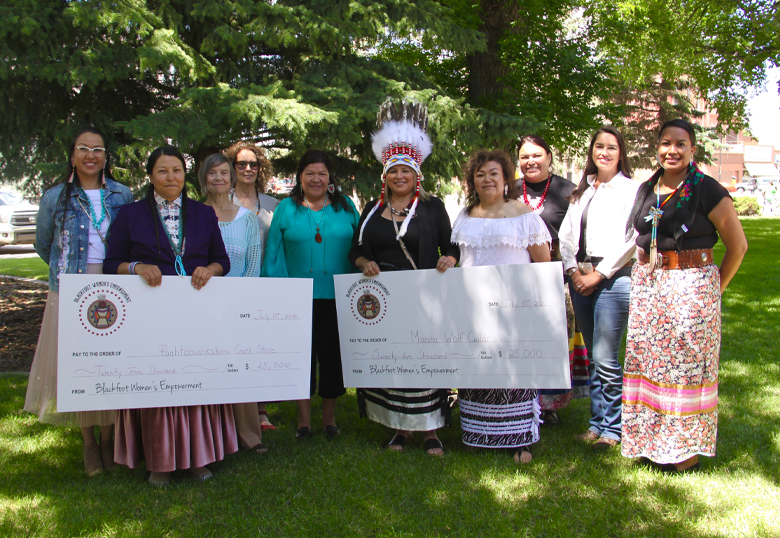When Tanya Pace-Crosschild (BSc ’98), director of the Opokaa’sin Early Intervention Society, saw a call for proposals from Women and Gender Equality Canada in 2018, she immediately recognized an opportunity to develop a project to foster the economic empowerment of Indigenous women in southern Alberta.
“Many of our families are living below the poverty line and Blackfoot women don’t have the same opportunities as a lot of other Canadian women,” says Pace-Crosschild. “We wanted to look at what economic prosperity means to Blackfoot women and how to go from economic security to prosperity, keeping in mind many of our women aren’t even at the security level.”
Pace-Crosschild reached out to her network of women, including, from the University of Lethbridge, Drs. Carol Williams (history, women and gender studies) and Jan Newberry (anthropology) and Rhonda Crow (BMgt ’99), coordinator with Indigenous Governance and Business Management at the Dhillon School of Business. They submitted a proposal and succeeded in getting $350,00 in funding for a three-year project called Blackfoot Women’s Empowerment from Security to Prosperity.

Now in their final year of funding, they recently launched the Blackfoot Women’s Empowerment website, a portal for Blackfoot women to access resources to enhance their entrepreneurial skills and learn more about traditional ways of life. In addition, the website highlights two projects the group has funded — the Paahtómahksikimi Cultural Centre online craft store and the Red Woman Talks series.
The online gallery and store showcases the talents of 10 artisans and includes artwork, jewelry, accessories, clothing, moccasins and more available for purchase through the click of a mouse. Red Woman Talks is designed to be a series of seven interviews featuring Indigenous women’s successes in communities within the Blackfoot Confederacy. Still in the planning stages, the goal is to inspire, empower and motivate by having role models talk about the challenges they faced and how they overcame them on their path to success.
This fall, the Blackfoot Women’s Empowerment group partnered with the Dhillon School of Business. Starting in January, Drs. Tanya Drollinger and Katie Lafreniere will lend their expertise in promotion to the two projects.
“We needed help in marketing and developing an online presence,” says Crow. “Hopefully, it will be an ongoing partnership because we’re hoping this project doesn’t end when the government funding ends. We’re looking at sustainability and how we can ensure this becomes a permanent program.”
The project began in 2018 with the formation of an Indigenous women’s council. With the help of Coby (Eagle Bear) Royal (BA ’08), they organized a series of meetings with Blackfoot women, both on and off reserve. Along with meetings in Lethbridge and Calgary, they met with women from the Siksika, Piikani, Kainai and Blackfeet First Nations to ask them how they define economic prosperity and what it means to them.
“The results were similar to what I had expected,” says Pace-Crosschild. “Economic prosperity to Indigenous families is not just based on money. It’s based on relationship — relationship with each other, to the land, and to the resources within the community.”
Following the meetings, the women developed a community plan and were asked to submit proposals to Blackfoot Women’s Empowerment. Crystal Good Rider (Ba/BEd ’04, MEd ’10) was hired as project manager to help implement the successful proposals.
“The website was developed in response to what the women were saying in the community needs assessment,” says Good Rider. “When you empower the women, you empower the whole community. There are so many challenges, but this is one positive. Everything we do has been guided by the Blackfoot women’s voices.”
The women identified needs for including cultural content, showcasing Blackfoot women role models and providing entrepreneurial opportunities for women.
“With the website, we’ve been able to work with the Paahtómahksikimi Cultural Centre to highlight artists within the community,” says Good Rider. “With that project, we were really focused on the collective effect of their proposal.”
Newberry says Blackfoot Women’s Empowerment highlights the many connections between the University and the larger community. Almost all the women involved in the project are either employees, faculty or alumnae of the U of L.
“This is a very exciting project,” she says. “It’s been going on for a while and we’re finally seeing some of the fruits of our labour. We used an assets-based model and the projects we’re supporting definitely build on the strengths that already exist among Blackfoot women.”
